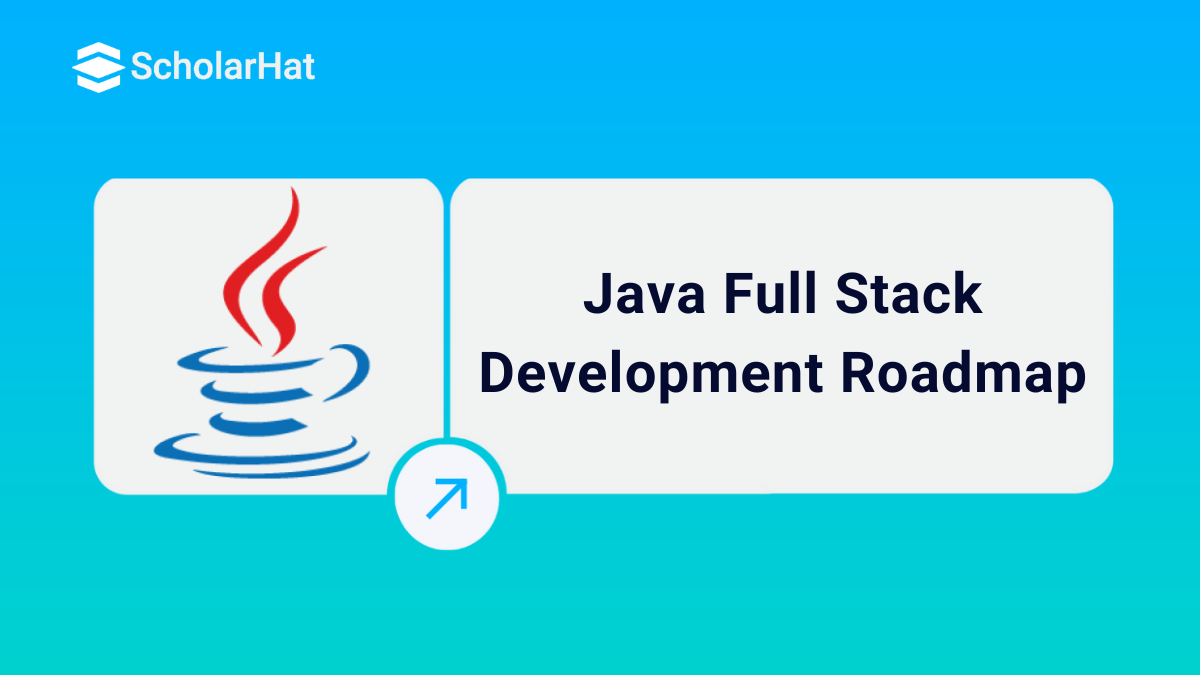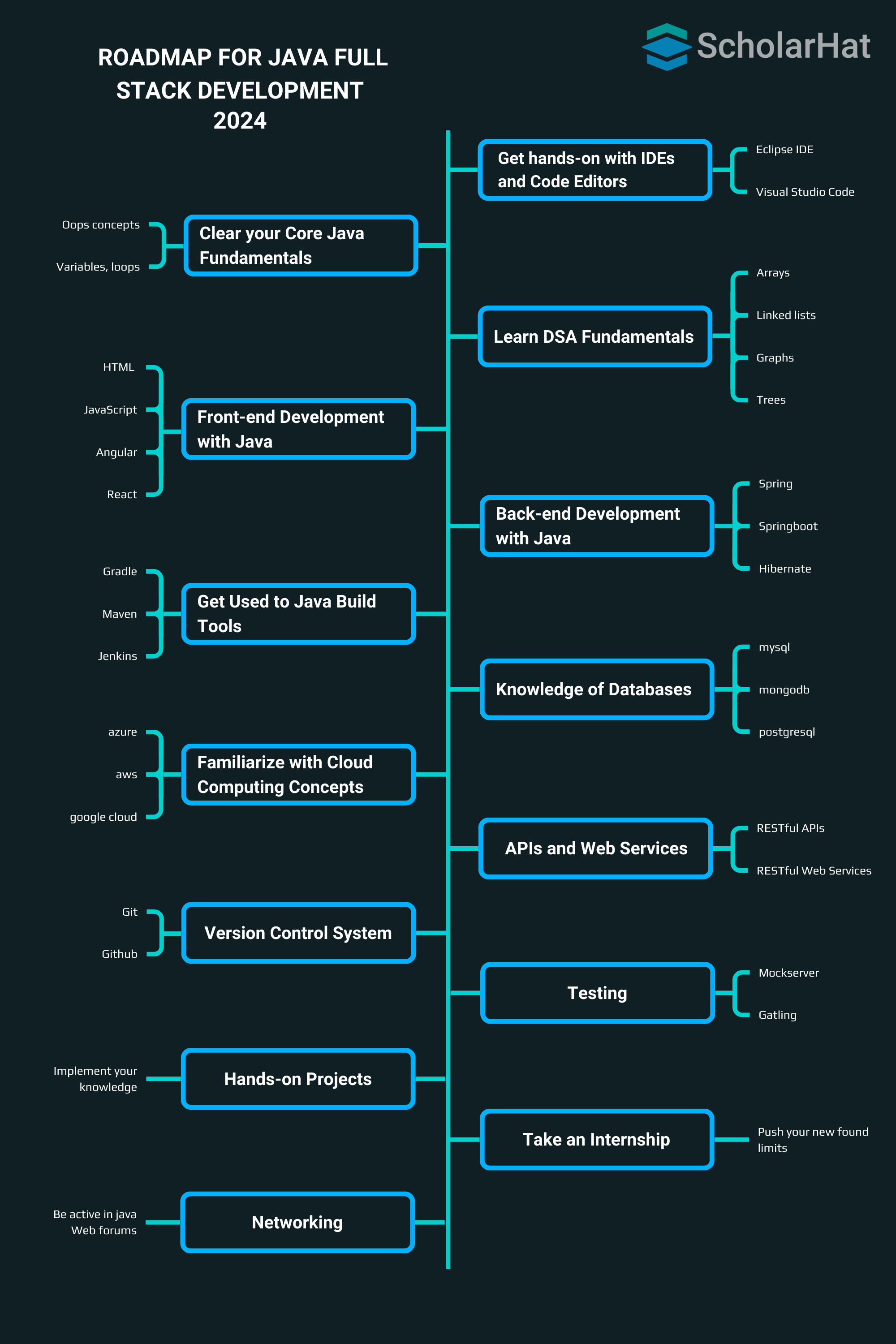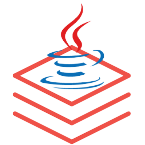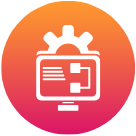26
DecJava Full Stack Developer Roadmap for Beginners (Updated 2025)
What is Java Full Stack?
Java Full Stack Development utilizes Java as its base technology for both front-end and back-end development. It involves designing and developing user interfaces, creating server-side logic, integrating various components, testing and debugging applications, and deploying the final product to production servers.
If you are a Java developer and want to become a full-stack Java developer, you are in the right place. If you are a Java beginner and want to become a Java full-stack developer, you are also in the right place. In this Java tutorial, we'll deep-dive into the Java full-stack developer roadmap. Along with this, we’ll explore the Java roadmap to guide you step-by-step. You just need to follow it sequentially and see the results.
To fast-track your learning journey, consider enrolling in our Java Online Course Free With Certificate.
Who is a Java Full Stack Developer?
A Java Full-Stack Developer is a software engineer who uses Java as their base technology and specializes in front-end and back-end development. They are skilled in designing interactive UIs using HTML, CSS, and JavaScript. They also implement server-side logic using popular Java frameworks like Spring, Spring Boot, and Hibernate. They create and maintain application programming interfaces (APIs) to facilitate communication between the front end and back end.
Become a Full-Stack Developer with ScholarHat's specialized Training & Certification programs. | |
| Training Name | Price |
| Full-Stack Java Developer Certification Training Course (A Proven Curriculum to Get a Software Job of ₹3 - ₹9 LPA*) | Book a FREE Live Demo! |
| Read More about Full Stack Development in our Full Stack tutorial. |
Embark on the Journey of Becoming a Full-Stack Java Developer
1. Get hands-on with IDEs And Code Editors
First, go to Java's official website and download the latest version. Once the installation is done, you can write and run Java code with IDE. You should know how to use the popular IDEs and Code Editors to write the code in Java. The famous IDEs are
- IntelliJ IDEA
- Eclipse IDE
- Visual Studio Code
- Microsoft Studio Code
Install any one of these IDEs on your computer system and start coding in it.
2. Clear your Core Java Fundamentals
Start with the foundational topics and get conceptual clarity regarding Java Core Concepts. The following topics will be covered under this:
- Variables in Java: Local, Instance, and Static Variables
- Data Types in Java - Primitive and Non-Primitive Data Types
- What are Operators in Java - Types of Operators in Java ( With Examples )
- Conditional Statements in Java
- Loops in Java
- OOPs Concepts in Java: Encapsulation, Abstraction, Inheritance, Polymorphism
- Exception Handling in Java
- Multithreading in Java
3. Learn DSA Fundamentals
Data structure is a fundamental building block for all critical operations on data. It is the branch of Computer Science that deals with arranging large datasets so that they can be accessed and modified as per the requirements. Learning DSA helps to improve your coding capabilities and problem-solving approach and enhance your real-world project development techniques.
Data Structures
- Arrays: A collection of elements of the same data type stored at contagious memory locations that can be randomly accessed with their index number.
- Linked Lists: A series of connected nodes that are randomly stored in the memory.
- Stack: Works on theLast In, First Out(LIFO) principle.
- Queue: Works on the First In, First Out (FIFO) principle.
- Graphs: It is composed of a set of vertices( V ) and a set of edges( E ).
- Trees: They are also collections of vertices and edges, but there can only be one edge between two vertices.
Algorithms
- Searching Algorithms: Finds the location of an element in a collection. Examples: Linear Search, Binary Search.
- Sorting Algorithms: Arrange the elements in a particular order. Examples: Bubble Sort, Selection Sort, Merge Sort.
- Graph Algorithms: Breadth-first Search (BFS) and Depth-First Traversal (DFS) are the two main algorithms for traversing the graph.
- Dynamic Programming: This algorithm uses the already-found solution to avoid repetitive calculations of the same part of the problem.
- Greedy Algorithm: It is an algorithm paradigm in which the solution is built part by part.
| Read More: DSA Roadmap: A to Z Guide to Learn DSA From Scratch |
4. Front-end development with Java
Front-end development is also referred to as client-side development. It means building a website or online application's User Interface (UI). It determines how each website element will appear and work. Everything you see when you visit a website, such as the buttons and UI components, media, messages, forms, and animations, is produced under the front end.
There are three fundamental front-end technologies that any front-end developer must know. The following are:
- HTML: It is the basic building block of web pages. You can build a single web page for the whole application using HTML. It is used to create any website's "skeleton" or foundation.
- CSS: CSS stands for Cascading Style Sheets, which allows you to apply styles such as colors, fonts, layouts, and animations to your web pages. It also allows you to create responsive websites that adjust their design and styles based on the resolution and orientation of the user's device.
- JavaScript: It increases the website's interactivity. You may design dynamic UI components using JavaScript. It determines what the page will do. It is a lightweight, open, and cross-platform programming language used by developers worldwide to build excellent websites.
| Read More: Frontend Developer Roadmap For Beginners 2024 |
Along with these primary languages, you should also know some frameworks and libraries like:
- Angular: A component-based framework for building scalable online applications and a collection of well-integrated tools and modules for developers.
- React: Also known as ReactJS, React is a famous front-end JavaScript toolkit for creating user interfaces and associated components. Its distinctive features are Virtual DOM and how it manages document access and modification.
- Vue: Vue is a Javascript-based framework for building extensive user interfaces. It can power sophisticated Single-Page Applications (SPAs).
5. Back-end development with Java
The back end stores and arranges data and also ensures that everything on the client side of the website works fine. It is mainly the part of the website we cannot see and interact with.
Java consists of some popular frameworks for backend development. They are:
- Spring: You can build applications from “plain old Java objects” (POJOs) and apply enterprise services non-invasively to POJOs. It provides comprehensive infrastructure support for developing Java applications to help you focus on application-level business logic. There's no need to worry about deployment environments.
- Spring Boot is a module of the Spring framework that reduces development, unit test, and integration test time for programming standalone, production-grade Spring-based applications. There is no requirement for XML configuration (deployment descriptor).
- Hibernate is an object-relational mapping tool for Java. It maps an object-oriented domain model to a relational database, eliminating the need for complex SQL queries for data persistence and retrieval. Hibernate provides its own query language (HQL), which is similar to SQL.
| Read More: Backend Developer Roadmap 2024 |
6. Get used to Java Build Tools
Build tools help in implеmеnting thе build automation procеss within a softwarе dеvеlopmеnt еnvironmеnt. They strеamlinе and simplify thе build procеss and their usagе dеpеnds on thе spеcific nееds and tеchnologiеs еmployеd in thе projеct. Based on purpose, there are various types of Java Build tools.
Some of the popular Java Build tools you must learn are:
- Gradle: It is an open-source Java build tool. Gradle is frequently recognized as the best build tool for deploying Java applications.
- Apache Maven is an open-source software project management tool for building and managing Java-based projects. It uses conventions for the build procedure.
- Jenkins is an open-source automation server for CI/CD pipelines. It can construct Java applications regardless of the frameworks utilized in building them.
7. Knowledge of Databases
Databases are collections of organized data stored on a computer system. You need to perform CRUD(Create, Read, Update, Delete) operations on data present in databases. So, it's essential to have a good understanding of DBMS. There are several types of databases, including relational, NoSQL, object-oriented, hierarchical, network, and graph databases.
- MySQL is a multithreaded, multi-user, open-source relational database management system based on Structured Query Language(SQL). It provides MySQL Connector/J to connect client apps developed in Java.
- PostgreSQL is an advanced open-source object-relational database that supports both relational (SQL) and non-relational (JSON) queries. PostgreSQL JDBC driver connects a Java program to the PostgreSQL database server.
- MongoDB is an open-source NoSQL database management system written in C++. It provides a Java driver and Spring Data MongoDB for seamless integration with Java.
- MS-SQL Server: Microsoft developed this Relational Database Management System(RDBMS). It is designed to run on a central server so that multiple users can access the same data simultaneously.
8. Familiarize with Cloud Computing Concepts
Cloud computing has emerged as a critical component of modern software development in today's quickly changing technological landscape. It eliminates the need for individuals and businesses to self-manage physical resources themselves and only pays for what they use.
Explore cloud computing deployment models like private, public, and hybrid cloud and cloud computing service models, i.e., IaaS(Infrastructure as a Service), PaaS(Platform as a Service), and SaaS(Software as a Service).
| Read More: What is Cloud Computing? A Beginner’s Guide to Microsoft Azure |
The three major cloud providers you should know about in 2025 are:
- Amazon Web Services: It is the world’s most comprehensive and broadly adopted cloud platform. It offers nearly 200 fully featured services to individual developers, large enterprises, and even governments.
- Azure: Azure stands out as a comprehensive platform that provides a wide range of services for developing, deploying, and administering cloud applications.
- Google Cloud is the smallest of the three cloud providers, yet it offers robust cloud services to power and support any application. It currently offers over 100 services in computing, networking, big data, and more.
| Read More: What's the Difference Between AWS vs. Azure vs. Google Cloud? |
9. APIs and Web Services
- RESTful APIs: REST is an architectural style for designing communication interfaces.
- RESTful Web Services: Learn how to build RESTful web services using frameworks like Jersey or Spring MVC. These frameworks provide tools and functionalities to expose functionalities within your back-end to other applications or front-end components through well-defined APIs.
10. Version Control System
A version control system is a tool that helps both the backend and frontend developers collaborate and control the changes made over time. It also gives details about what kinds of changes should be made and by whom. Therefore, a version control system enhances project speed by allowing developers to interact, removing the possibility of errors, and recovering the code if any accident occurs.
The following are the standard version control platforms:
- Git
- GitHub
- GitLab
- BitBucket
11. Testing
Ensuring the reliability and functionality of web applications is paramount. It involves verifying the application behaves as expected and meets the required specifications.
The following are the testing methods used by the developers:
- Integration testing
- Unit testing
- Functional testing
- End-to-End Testing
Following are the various testing resources you must use for testing Java applications:
- Assertj
- CitrusFramework
- Cucumber-jvm
- Gatling
- Hoverfly-java
- Mockserver
- Rest-assured
- Truth
12. Implement your knowledge through Hands-on Projects
As a full-stack Java developer, building a solid portfolio with projects is crucial for demonstrating your skills and experience to potential employers or clients. Focus on creating high-quality projects that solve real-world problems and demonstrate your expertise.
13. Take an Internship
Internships are a fantastic opportunity to gain real-world experience, learn new skills, and network with industry professionals. Through internships, you get to work on real projects and collaborate with experienced developers, explore different industries and technologies, gain valuable experience, expand your network, and increase your chances of success as a software developer.
| Read our Top 50 Java Full Stack Developer Interview Questions and Answers |
14. Develop a Good Network
Developing a good network is crucial for finding job opportunities and advancing your career. Networking involves building professional relationships with people in your industry, such as colleagues, mentors, recruiters, and alumni. It can be done both in person and online through social media platforms such as LinkedIn.
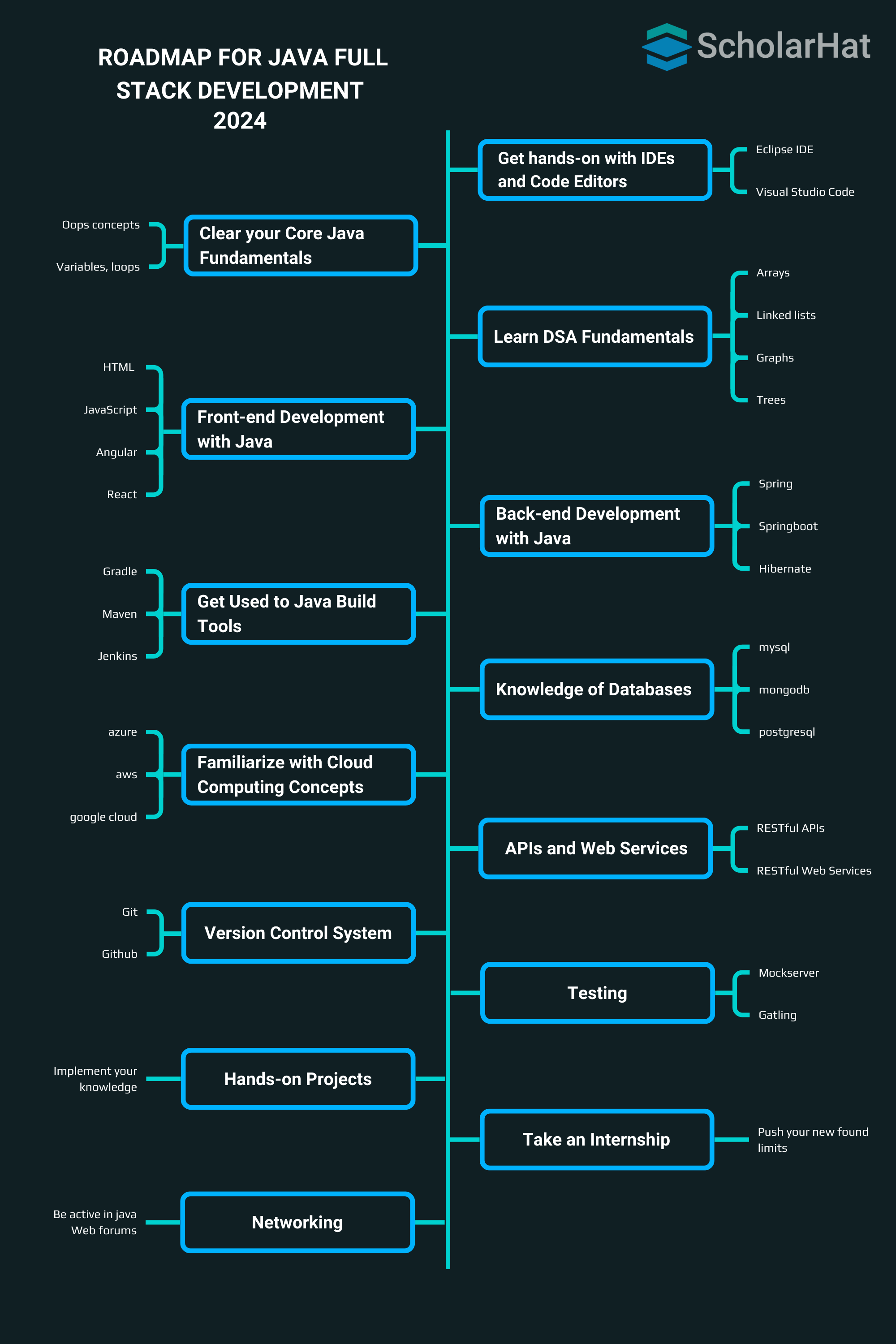
Career Opportunities and Growth
- Full Stack Java Developer: You'll be responsible for designing both the front and back end of applications.
- Front-End Developer: If you have a more profound interest in user interface design and user experience, you can specialize in front-end development.
- Web Developer: This position typically emphasizes back-end development, and the developer is responsible for implementing and maintaining server-side code. As many servers are moving to the cloud these days, developers should have experience and skills in coding in a cloud environment.
- Java Architect: Traditional architects design buildings. Java architects design and develop the look and feel of an application.
- JavaEE Developer: These developers create and maintain enterprise software and are usually employed by large companies.
- Java Android Developer: Android mobile operating systems have a significantly larger market share than iOS, so there is more demand for professionals who can create or add features to Android-based apps.
Go through the Related Interview Questions Articles: |
Summary
To become a full-stack developer, you need dedication, patience, and perseverance. You will face several challenges in your journey. Sometimes, the UI will not be appealing, and other times, the database will not be integrated. It would help if you implement what you learn.
Java is a highly used language in almost all big enterprises like Amazon and Flipkart. Enrolling in a Full Stack Java Course can be a great starting point to enhance your skills. Also, step into the role of a Solution Architect—our Java Solution Architect Training today.
FAQs
Take our Java skill challenge to evaluate yourself!

In less than 5 minutes, with our skill challenge, you can identify your knowledge gaps and strengths in a given skill.

